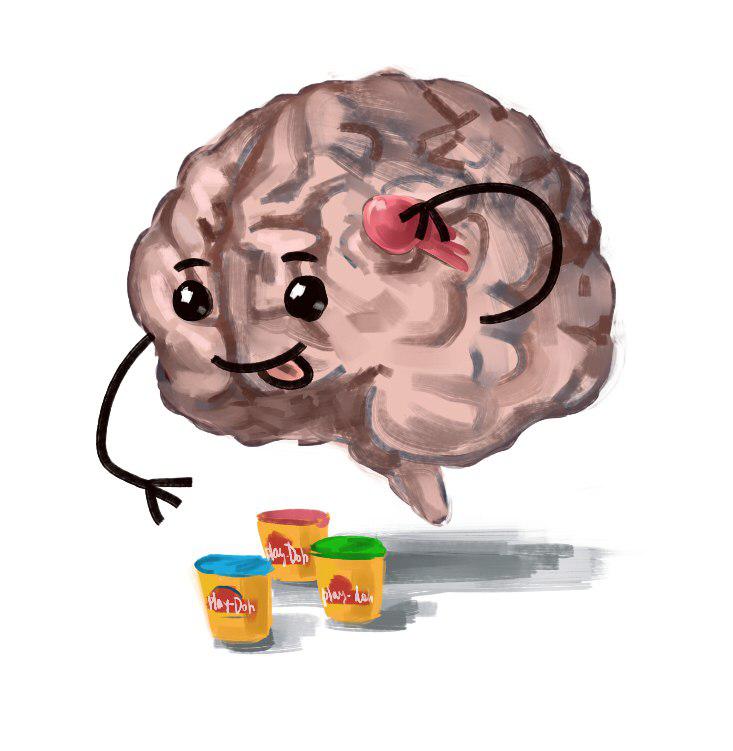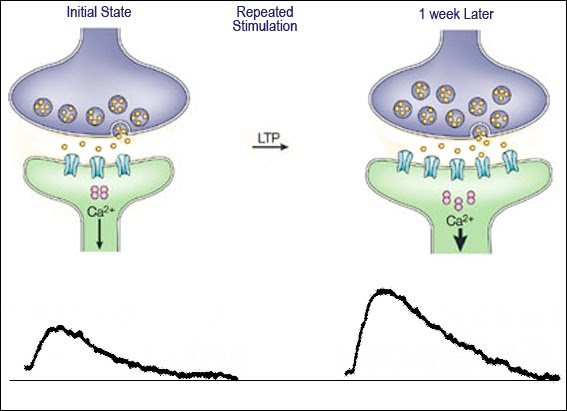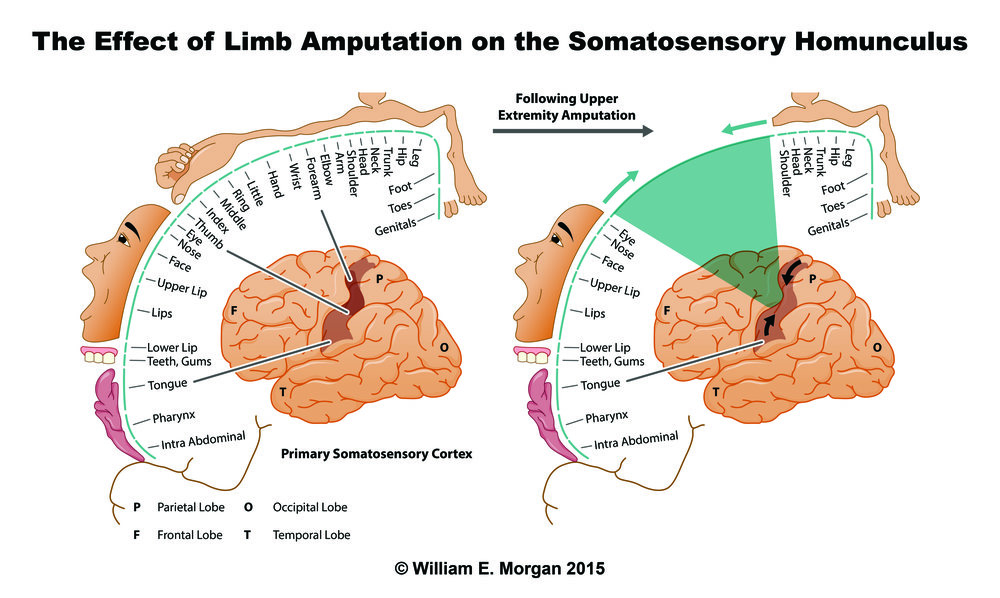Neuroplasticity: rebuilding the brain

Our brain is extremely plastic. Not like plastic tableware or a Barbie doll - in neurology, plasticity means the brain's amazing ability to change and adapt to almost everything that happens to us. In the old days, scientists believed that when a person ceased to be a child, his brain froze like an earthenware pot, and remained in one form. But the bales of research have refuted their opinion - the brain is more like plasticine [play-doh]. These changes can occur at different scales: from a single neuron that changes connections, to a whole cortical region, decreasing or swelling. The structure of the brain can change many factors, from injuries and strokes to meditation, exercise or daily piano lessons. And like everything in life, plasticity is a double-edged sword. Plus the fact that the brain can rebuild itself during rehabilitation after a stroke. Minus - phantom pain after loss of limbs. Let's see how, what and why is happening.
Let's start with a small scale and synaptic plasticity (if you don’t know what a synapse is, first read the introductory article about the brain ). This kind of plasticity, which is often referred to as long-term potentiation (LTP) and long-term suppression (DFD), is critical for our understanding of the processes of memorization and learning. Very simply, it works like this: the connections between neurons are strengthened or weakened (potentiation or depression occurs) depending on their actions. When neuron A constantly energizes neuron B, the connection between them is enhanced.

')
Naturally, this usually happens on several synapses - so whole networks may appear, in case they have been active enough just in such a composition (and we believe that memory is formed approximately the same). So kiss your soul mate often enough while listening to Lou Beg's songs, and soon the song “Mambo number five” will make you feel romantic. Donald Hebb [Donald Hebb], a Canadian neuropsychologist, came up with the saying “Run together, together together” [What fires together, wires together] to describe this process. Initially, these bonds are fragile, but if you activate them a sufficient number of times, they will turn into strong (they can not be divided, like Britney and Justin in the 99th). The reverse process, DPD, is started by another stimulation procedure, and is believed to weaken unnecessary connections — you forget the name of your former or refine new dance moves. Synapse plasticity is a concept that cognitive and behavioral therapists recommend to their patients: to change established mental patterns, you need to form new ones step by step through practice. And new paths are evolving from dirt roads to highways (along which healthy behavior moves), and broken contours float away into oblivion.
Plasticity on a large scale is manifested differently. A growing amount of research shows that the more you use a certain muscle, the more brain allocates a large area for it. For example, one study shows that although the areas responsible for finger movements are usually the same size, this is not the case. After five days of exercise on the piano, certain and quite visible changes were found in the motor area of the cerebral cortex. The areas responsible for finger movements expanded and occupied other parts of the neighboring areas, like weeds growing in a garden. The researchers went even further: they showed that even if the subjects were thinking about the exercises, the effect was almost the same! Mental exercises proved to be as effective in reorganizing the brain structure as physical exercises. Another example (about which neuroscientists have heard, probably more often than the residents of Bible Belt - areas of the United States, where Protestant fundamentalism is especially strong about Jesus) - is London taxi drivers. Experienced taxi drivers who have to memorize a map of the capital, including tens of thousands of streets and dozens of sights, have a large posterior hippocampus - a brain structure responsible for spatial memory and orientation. The control group, bus drivers with regular and well-established routes, has a hippocampus of normal size. To prevent the usual comments like “correlation does not guarantee causality” (after all, maybe the increased size of the hippocampus led the taxi drivers to this job?), The researchers showed that the increase in hippocampus correlated positively with the time spent behind the wheel. The longer you drive, the more your brain adapts.

Do you already agree that the brain is incredibly plastic? Do not hurry, we have more examples. If you abandoned meditation as a hippie nonsense, note: the long-term practice of meditation is associated with very positive changes in the brain. Think of it as a workout — like piano lessons. Studies show that if you sit quietly and meditate, you can increase the thickness of the cortex (that is, more gray cells, that is, more neurons for signal processing) in areas related to attention, memory, and emotional control. Moreover, the amygdala, the center of reactions associated with fear and aversion, decreases and weakens the connections with the prefrontal cortex, the place where the highest executive functions are located. Simply put, meditation allows you to respond to stress more thoughtfully and to suppress instincts. Last but not least, the network of the passive mode of the brain responsible for self-determination and day-to-day dreams also reduces activity, which allows less distraction (and prevents thoughts from jumping from yesterday's party to the inevitability of death or something like that). And while I'm here doing the hidden propaganda of healthy lifestyles , I will mention that physical exercises also change your brain for the better. Just three hours of fast walking per week increases the growth and birth of nerve cells, which, in turn, prevents the age-related decrease in the brain. Research shows that the anterior regions and the hippocampus are particularly beneficial - that is, their volume has grown after long exercises. Here you have an example of how memory and reasoning ability are improved thanks to healthy lifestyles.

Your brain, like a perfect spouse, exists with you in good times and in bad, in sickness and in health. After a trauma or stroke, neuroplasticity helps you. Rehabilitation training after a stroke or injury showed that the brain is reorganizing around the damaged region. Suppose a stroke damaged the part of the brain responsible for the movements of the left hand. The use of technology called “forced mobility therapy” (when you are forced to use a “bad” hand while restraining the other hand), leads to an increase in the amount of gray matter in the motor section, changes the regions adjacent to the damaged so that take on its functions and even make the contralateral hemisphere participate in the recovery. The brain rebuilds itself to adapt to new circumstances and to do it in the best possible way. However, it does not always go so well. Sometimes the brain can put a pig in and cause you trouble - this is me about phantom pains. You've probably heard of people who still have the feeling of amputated arms or legs. This is also the merit of our restless plastic brain, although this process has not been studied 100%. One of the generally accepted theories says that the area of the somatosensory cortex, adjacent to the one that was responsible for the functions of the missing limb, grabs a new opportunity and takes the vacant place. For example, the face area is located near the hand area. And if you lose a hand, the face area takes the place of its neighbor and perceives all the sensations of the face doubly: from those coming from the cheek and from a nonexistent thumb.

It becomes clear that we are not limited to those cards that nature distributed to us: it is possible to change some of them (and this will not even be perceived as cheating). The brain reflects our environment, our decisions, our emotions and our lifestyle, and it’s never really too late to change all that.
Sources:
LTP
Piano and plasticity 1, 2
Taxi drivers
Meditation and DMN
Meditation and amygdala
Meditation and increased cortical thickness
Brain and exercise 1, 2
Constraint-induced movement therapy
Phantom pain
A great meditation resource
Pictures by Toma
Source: https://habr.com/ru/post/372639/
All Articles